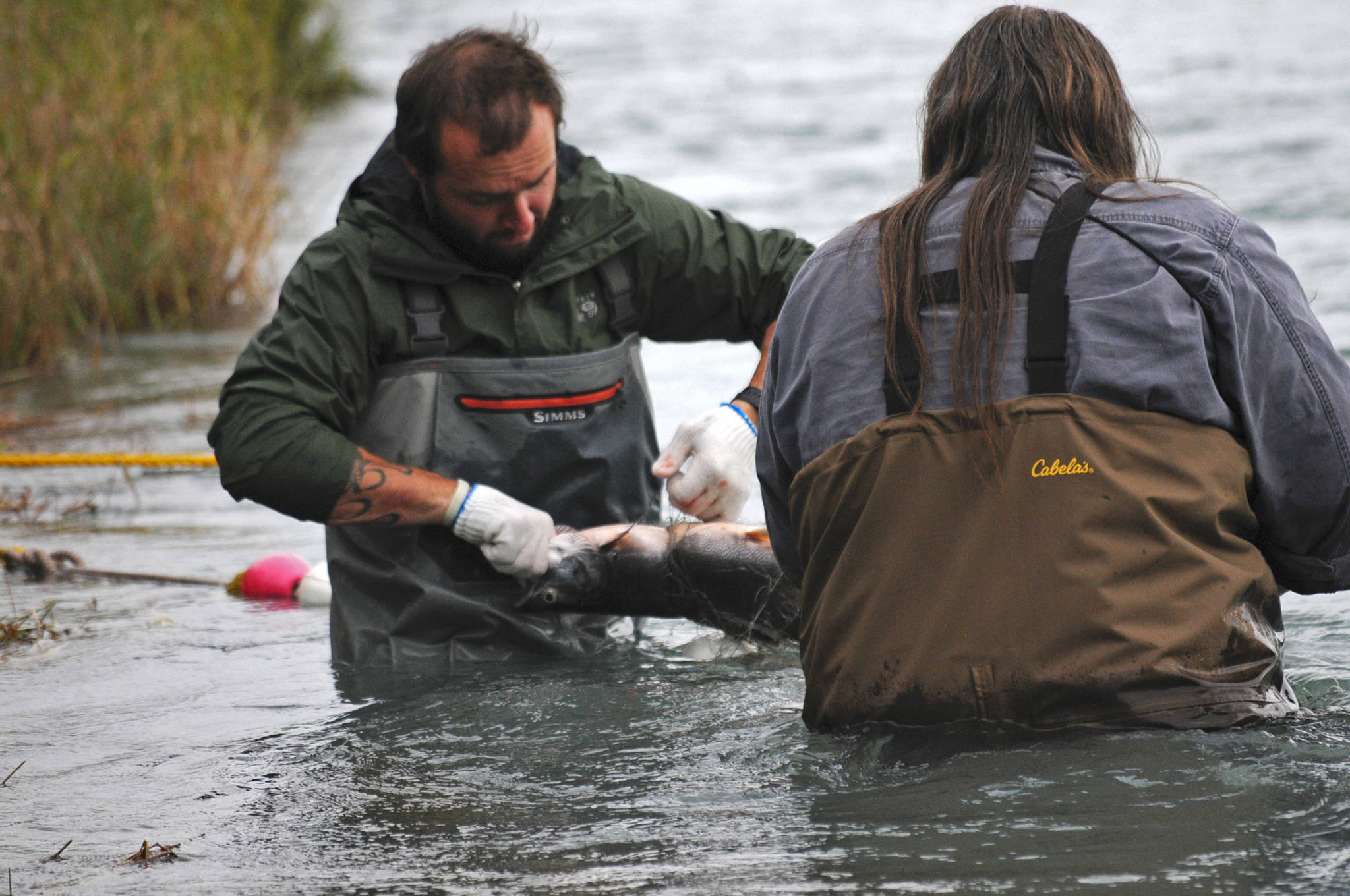The gillnet operation in the Kenai River run by the Ninilchik Traditional Council this summer concluded its season with only one king salmon caught and no encounters with rainbow trout or Dolly Varden.
The Ninilchik Traditional Council fished with gillnets on the Kenai and Kasilof rivers this summer for a total of 33 days — 22 on the Kenai and 11 on the Kasilof. In those days, the fishermen harvested 2,169 sockeye salmon from the Kenai and 315 sockeye from the Kasilof. One king was harvested on the Kenai River as well, while the one king caught in the Kasilof net was released, according to the final fishery reports for the season.
It’s precisely what the tribal government said would happen on the Kenai, despite concerns from other users and the U.S. Fish and Wildlife Service about the net harvesting too many kings or resident species, said Ninilchik Traditional Council Executive Director Ivan Z. Encelewski. The area they set the net is close to the bank in the Moose Range Meadows area, and based on observation and some scientific data, the tribe was confident they wouldn’t risk catching too many kings, he said.
“The area that we’re fishing, really close to the bank like that, the kings don’t run like that,” he said. “They run in the deeper channels in the middle of the river. When you’re fishing in that area that we are, with the small net really close to the bank, we’ve kind of felt all along and the patterns proved themselves that the fishery doesn’t encounter kings in the area.”
It’s the second year the tribe has been able to fish the gillnet on the Kenai River, after a protracted fight that ended in legal action. Though the fishermen are tribal employees and the program is administered by the Ninilchik Traditional Council, the fishery is open to all qualified rural residents in the Ninilchik area. They sign up to take part in the fishery and turn in their permits, and fish are distributed at the end of the fishing day to those who have submitted permits. The fishermen, who have to be Ninilchik Traditional Council employees, can only take as many fish as they are authorized to by the number of permits they have and have to keep meticulous track of the fish they encounter and harvest.
In 2016, the fishery was still experimental and authorized only for one year. The tribe received approval for the 2017 season in April with revised conditions, negotiated between the tribe and the U.S. Fish and Wildlife Service, which administers the waters where the tribe fishes on the Kenai River.
During the approval process, users both upstream and downstream of the proposed site objected, some with concerns about fishery allocation and others with concerns for kings and resident species. During a hearing in Anchorage on Feb. 24, a number of guides and local residents on the central Kenai Peninsula and in Cooper Landing and Hope’s subsistence communities objected to the net, mostly with concerns about Ninilchik’s net encountering too many Dolly Yarden and rainbow trout. Partly in response to that concern, a condition of the approval was that the fishery would close if the net encountered more than 100 rainbow trout or 150 Dolly Varden.
The area they chose to fish, a channel on the north side of the river, produced sockeye well and they chose to leave the net there this year, Encelewski said.
“We want to kind of stick with what works and what was working,” he said. “(We had) concerns with getting into areas where there might be other higher rates of harvest for other species.”
The objections from the community lessened this year, which Encelewski attributed to the harvest data. The fishermen largely focused on the Kenai during the height of the sockeye run to maximize harvest per number of hours of effort, though they fished a few days in September for silvers before deciding the time wasn’t worth it for the silver harvest they were seeing, he said.
Fish and Wildlife doesn’t have any concerns about the fishery either, said Gene Peltola, the assistant regional manager for the Office of Subsistence Management in Alaska. Like other areas of Alaska where people fish for subsistence, the tribe’s fishermen seemed to be able to judge where they could fish to only encounter sockeye, their primary target species, he said.
“People who are familiar with the river can identify and target areas to minimize the harvest of non-target species,” he said. “…I think everybody’s pleased that (the Ninilchik Traditional Council’s gillnet fishing is) turning out the way it has.”
Most of the members of the Federal Subsistence Board, the board regulating statewide subsistence practices, went down to visit the net site this summer, Peltola said. Encelewski said that visit helped the members visualize the net and clarify any misconceptions, such as the size of the net compared to the river. The net is 10 fathoms, or 60 feet, long, and bows in the current to where it only extends about 20–30 feet from the shore.
The number of people who submitted permits to receive fish increased this year, which led to some confusion and created some need and effort for participant education during the fishery, according to the final report for the Kenai fishery.
The second year of data further validated the tribe’s assertion that they could fish the Kenai and not endanger king salmon or resident species stocks, Encelewski said. The outcry from the public and concern from biologists proved to be unfounded, he said.
“(Fisheries managers are) managing on scientific and biological data that’s not always perfect, and we know it’s not perfect,” he said. “…We as the subsistence users said we could do this. Once again, the customary, traditional evidence proved that (managers) were wrong.”
Reach Elizabeth Earl at elizabeth.earl@peninsulaclarion.com.

